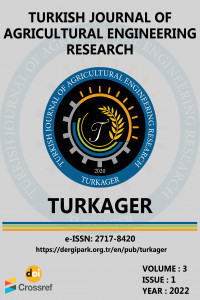Evaluation of Cassava Effluent as Organic Admixture in Concrete Production for Farm Structures
Evaluation of Cassava Effluent as Organic Admixture in Concrete Production for Farm Structures
Cassava effluent, cassava starch concrete, hydrocyanic acid, organic admixture,
___
- None
- Yayın Aralığı: Yılda 2 Sayı
- Başlangıç: 2020
- Yayıncı: Ebubekir ALTUNTAŞ
Evaluation of Cassava Effluent as Organic Admixture in Concrete Production for Farm Structures
Hilary UGURU, Ovie Isaac AKPOKODJE, Goodnews Goodman AGBI
Sultansuyu Tarım İşletmesi Süt Sığırcılığı Faaliyetlerinde Girdi ve Maliyetlerin Belirlenmesi
Veysel Kaya YIĞMATEPE, Mehmet Metin ÖZGÜVEN
Moisture Influence on Some Physical and Gravimetric Properties of Ackee Apple (Blighia sapida) Seeds
Olajıde SADIKU, Davıd OMOGUNSOYE
Development of a Low Cost Two- Row Groundnut Planter
Adewale SEDARA, Roseline LANWO, Oluwadunsin SEDARA
Çorum İlinde Çeltik Tarımında Makina Kullanım Projeksiyonun Tahmini
Meyve Kurutma Yöntemlerine Göre Tüketici Tercihleri: Sunburst Çeşidi Mandalina Örneği
Esra KAPLAN, Muhammed TAŞOVA, Hayriye Sibel GÜLSE BAL
Sodyum Aljinat Kaplama Uygulamalarının Az İşlem Görmüş Elma Kalitesine Etkileri
Şeyda KARAGÖZ, Aslihan DEMİRDÖVEN
